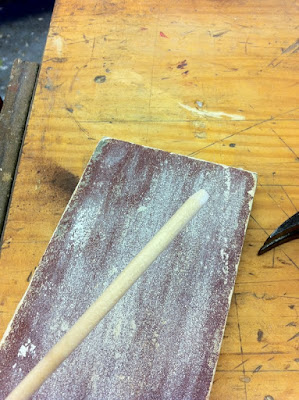Zip to the present and the current problem with the great deal knobs.
The brass is tarnished, it is to close in shade to the cabinet color, that wonderful honey oak, and the biggest problem of all? The kids (16, 15, and 13) keep catching their clothes and tearing them on the knobs. I have got caught on them also, but not done damage. We've also had guests have problems with them also. I just couldn't see spending on average of $4 a knob to replace the 40 or so I would need.This is an OLD photo of our kitchen, but the only one I could find that showed all of it. We recently repainted a warm yellow (which ended up the same tone as the cabinets, which is why painting the cabinets is next on my list). It is large and has LOTS of cabinet space, so it would be expensive to replace knobs.
But recently while out at my local Goodwill, I found bin pulls from Target marked down to a package of 6 for $1.98, then I spied another package of 6 for $2.98. The cashier, though after looking at both, without my even asking, rang them up both for $1.98 each! So at least I could change the drawer knobs....
The old knobs were a single screw and the new knobs were double screws, so a little modifying needed to be done. I took all the drawer fronts off the drawers and removed the old knobs.
(It won't let me rotate this photo!) , anyway here are the old knobs, if anyone is interested I will be happy to mail 12 grape shaped knobs, slightly tarnished for the cost of shipping!
I then talked to Mr. Bruce (I take the kids to a woodworking class once a week, he is the most awesome teacher and woodworker, and I now take projects to work on also, and he teaches me along the way) about the best way to go about adding the new knobs.
Step one was to fill the old center hole. I found a dowel rod almost the size of the hole, sanded down the tip, and use a utility knife to trim off a piece that was slightly longer than the thickness of the drawer panel.
Next I pushed the plug I'd cut into the old knob's hole and used a hammer to wedge it further in and then use a bent handle saw (Mr. Bruce has all the good tools!) to trim it flush with the top of the drawer front. Since the new pulls would cover the old holes I didn't bother with filling in the top with wood filler, but when I paint the drawers I probably will.
Next I made a template the size of the raised portion of the front of the drawer panel, so that I could position all of the pulls properly, and marked the position of the new screw holes with another of Mr. Bruce's tools a punch, you could also use an ice pick or similar pointed tool to mark them. The benefit of the mark is it gives a starting point for the drill bit and keeps it in place when you start drilling.
(Again it won't put the photo in the right orientation!) The only problem I had with this marking, was I noticed that the screws that came with the knobs had a rounded head and would not sit flush with the back of the drawer panel, which would not allow me to replace it on the drawer. I knew I would need to countersink the screw head but wasn't sure any of the tools we had at home were the correct ones for the job, since I wanted them to be equal depth. So Mr. Bruce to the rescue again, with the correct bit on his drill press. But, the counter sink needed to be on the back of the drawer fronts, I had marked the fronts, so I had to redo my process and then drill the countersink holes. While we were setting the drill press up, and getting the proper depth on the hole, we accidentally did the countersink holes on the FRONT of one of the drawer panels. More slices of dowel cut and glued in, then trimmed off.
Next we drilled the center hole for the screw to go through,I got the correct sized drill bit by holding the drill bit behind the screw that came with the knob and looking for the one that was just slightly bigger than the screw. Once I had drilled through the center of the countersink hole (which is much easier than drilling the center hole first, then the counter sink hole), I put the new screws in place and tightened on a new pull to see the final affect. Problem. The screws were too long. So this time I knew what to do from previous Mr. Bruce teaching.
FIRST, screw a nut onto your screw, then position it in a vise (I marked the vise with a pencil mark to make sure I cut all the screws the same length), and use a hacksaw to cut the excess off the screw. AFTER cutting, unscrew the nut (it should be on the portion of the screw you are going to use, not the portion you cut off) and it will realign the threads that were pushed out of position during the cutting.
Since class was over I took the rest home to finish drilling with our hand held drill.
You can see the original hole in the middle, the two countersunk holes for the new pulls, and the smaller holes far right and left that the screws come into from behind to attach the drawer panel to the drawer. All of this is hidden.
Then the final of attaching the fronts back on the drawers. When we moved into this house in 2003 there were no knobs on the cabinets or drawers at all. I drilled and added the pants ripping grape and leaf knobs within the next year. Though I was always short of knobs for the 3 BIG drawers. I still am with these new pulls. I'll just keep searching until I find a good bargain. Until then, I plan to paint the leaf knobs that are on the cabinets with Oil Rubbed Bronze spray paint, distress a little, and wax to make them match the new pulls better.
If you are interested in the old grape knobs, be the first to leave me a comment about them, and I will mail them to you!
`New pulls with drawers with still no knobs and old brass leaf pulls new pulls with old brass leaf knobs painted with Old Rubbed bronze spray paint, distressed and waxed.
I'm linking this to Miss Mustard Seed's Furniture Feature Friday.
(Hopefully!)




















































